Science is not just for scientists. Citizen science has been instrumental in helping us understand more about the elusive, but majestic, transient killer whales.
|
Although killer whales garner a lot of public attention and interest, scientific jargon often makes it hard to appreciate these creatures fully. A user-friendly identification catalogue and field guide is trying to change that by using pictures and artwork from whale watchers, fishermen, citizen scientists, and researchers; these collective efforts allowed transient (Bigg’s) killer whales to be observed as they navigated their way through the central coast of California, and the open waters off Oregon, Washington, British Columbia, and even Alaska.
“This book is like a family album of killer whales. It has pictures that show when animals were born, how they’re related to each other,” said Dr. Andrew Trites, who oversees the Marine Mammal Research Unit at the Institute for the Oceans and Fisheries. “The field guide provides the backstories that give us some context of who these animals are, and why they matter. It makes science accessible, because scientists share information in a different format that the average person doesn’t have access to. This field guide has gone the extra step to synthesize all this knowledge and has put it in a format that is accessible to everybody.” For the general naturalist, and people who are interested in seeing killer whales and understanding them, this new guide focuses on the behaviour of transient killer whales, field methods, social behaviour, and diet, as well as the identification of the different killer whales that are seen off the coast of California. Nicknamed “wolves of the sea,” transient killer whales are fierce hunters who eat massive gray whales and all kinds of harbour seals, porpoises, dolphins, and sea lions. They live in small groups of 2-6 whales, with pods constantly breaking apart and re-forming over different periods of time. Individuals can be identified by their dorsal fin shapes (the upright fin on the top of the animal), post-ocular patch (the white shapes right behind their eyes), and any notches and scars on the dorsal fin and saddle patch (grey area by the fin). From May 2006 to April 2020, data on transient killer whales was collected based on at-sea observations and sighting reports along the west coast of North America, with the catalogue using over 95,000 photographs to identify (and re-identify) individual killer whales based on their markings and changing scars and marks. “Researchers keep an updated catalog, called a living catalog, and rely on them to keep track of the individuals. Much of what we know about killer whales has come because of our ability to identify individuals. And we can tell them apart and give them names, because they’ve got unique markings —in many ways, it’s like fingerprints,” said Trites. “Photographs are needed to keep the catalog up to date, but researchers can’t be on the water every day. However, whale watching boats are, and they become one of the big sources of images. Increasingly, it’s going to be citizen scientists, people who happen to be in the right spot at the right time, who provide these photographs.” Transient killer whales have extremely large geographical distributions. Due to the crossing of country borders between Canada and the United States, a large community effort was needed to map the distribution of these whales, collect data and photographs, and identify the individuals as they make their up and down the coast. Many photographs and data were also collected through volunteer efforts from whale watchers, researchers, fisherman, lighthouse keepers, naturalists, and members of the communities up and down the coast. NOAA also supplied photographs. “We actually created a Facebook page where people from the community could join it, and post their sightings,” said Josh McInnes, lead researcher and master’s student in the Marine Mammal Research Unit at the Institute for the Oceans and Fisheries. “We started to really learn that there’s more happening than what we thought before. As we got the information, we would ID the whales pretty much in real time. It’s exciting because we discovered new whales that are not part of our database or any database. So, we’re learning about new family groups and killer whales that are not known to science.” “I hope people really enjoy using it [the field guide] and that it helps them understand these animals more,” said McInnes. “I hope people are able to contribute more photographs now that they know there’s a place where they can submit data. This guide is just an opportunity to give back to all the people in these communities. This was kind of our gift back as a thank you.” NOAA technical memorandum NMFS-SWFSC; 644 Transient Killer Whales of Central and Northern California and Oregon: A Catalog of Photo-Identified Individuals was developed by McInnes, Josh D.; Mathieson, Chelsea R.; West-Stap, Peggy J.; Marcos, Stephanie L.; Wade, Victoria L.; Olson, Paula A.; Trites, Andrew W. for the United States. National Marine Fisheries Service.; Southwest Fisheries Science Center (U.S.); |
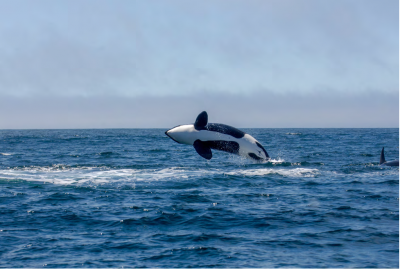 Breaching transient killer whale, Monterey Bay, CA—photograph by Peggy West-Stap 2012 | NOAA NMFS permit 15621 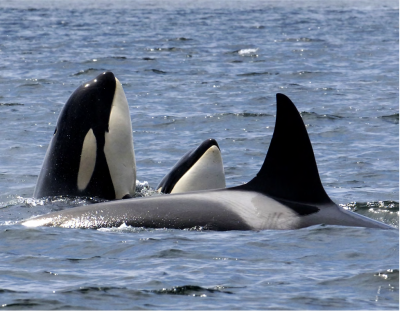 Transient killer whale OCT077 (dorsal fin) with her two offspring (spyhopping) in Monterey Bay, CA—photograph by Peggy Stap 2013| NOAA NMFS permit 15621 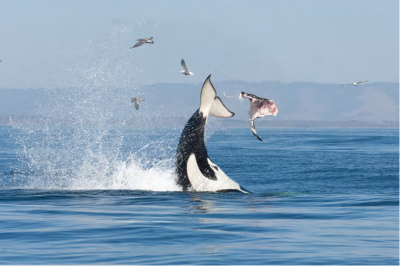 Killer whale catapulting a harbor seal—photograph by Peggy West-Stap 2008 | NOAA NMFS permit 1094-1836 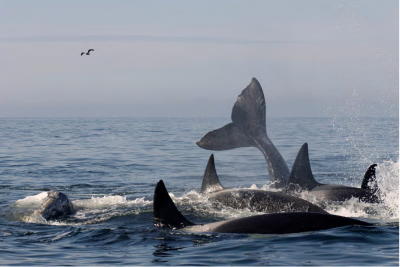 Transient killer whales hunting gray whales in Monterey Bay, CA—photograph by Peggy West-Stap 2005 | Photo usage approved by the Marine Mammal Laboratory and taken under MMPA Permit no. 782-1510 (Principal Investigator: Marilyn Dahlheim) 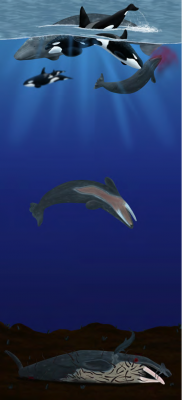 Depiction of a gray whale calf being hunted, then sinking to the sea floor where it provides nutrients to thousands of organisms—artwork by Selena Rivera |
Tags: Andrew Trites, citizen science, faculty, IOF students, Josh McInnes, Marine Mammal Research Unit, Pacific, Publications, Research, whales